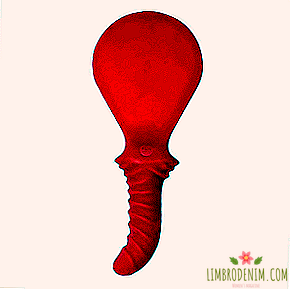Winter Blues: 10 facts about seasonal breakdown
Summer usually love more than winter, and not only for the opportunity to be in the fresh air and to organize open-air parties. The problem of the winter months is the lack of sunlight, which is associated with a condition known as "seasonal depression." In fact, autumn or winter breakdown is seasonal affective disorder (SAD). The term "seasonal dysthymia" is also encountered - but it is not entirely correct: speaking of dysthymia, they usually mean mild, but chronic depression, which does not correlate with the concept of seasonality.
If you do not delve into the terminology, then today we will talk about the fall, and then the winter breakdown, familiar to almost everyone. And if for some it results in a desire to sleep more, move less and spend evenings at home, wrapped in a blanket, then for others it can have serious consequences. Scientists are increasingly saying that the importance of seasonal affective disorder is underestimated and should be considered as a complete form of depression.
Text: Marina Levicheva

What is it all about?
According to the Mayo Clinic, seasonal affective disorder is a variant of depressive disorder associated with a change of seasons. As a rule, changes in mood, sleep and wakefulness, appetite and energy levels occur in the fall, when the weather begins to change. It is estimated that 1-2% of the population of the planet face SAD, while already 10-20% of people are familiar in a milder form.
According to the US National Institute of Mental Health, these are all the same symptoms as for depression: loss of strength, loss of interest in activities that once brought pleasure, disturbed sleep quality, fluctuations in appetite and weight, lethargy and inability to concentrate in severe cases - thoughts of death. The characteristics of winter affective disorder are drowsiness, overeating, craving for carbohydrates, and diminishing social contacts, while summer affective disorder (which is less common) has poor appetite with associated weight loss, insomnia, anxiety, and motor restlessness, also known as agitation.
How SAD is different from depression
Independently distinguishing seasonal disorder from depression is quite difficult. The problem is that the word "depression" can mean both the spectrum of symptoms and the diagnosis - clinically significant depression is considered to be one that disrupts normal human life. According to the new version of the Diagnostic and Statistical Manual of Mental Disorders, to which experts around the world are oriented, any changes in mood require attention if the situation does not change for two weeks or more. Norman Rosenthal from Georgetown University, who discovered the condition after experiencing it himself, moved to the United States from South Africa in 1976, says it is as hard as depression, but seasonally adjusted.
Even more confusion begins when we try to understand whether SAD and the "winter blues" are one and the same phenomenon. While some experts are confident that the "winter blues" even makes a person more gloomy, but in general does not interfere with enjoying life, others say that it is about the same thing. In other words, everything is very difficult. Especially when you consider that seasonal seasonal disorder can mask bipolar disorder with seasonal manifestations, while SAD itself has a subtype in the form of subsyndromic seasonal affective disorder (sub-SAD), which, however, may be another name for the "winter blues". What the doctors agree on is that the seasonal affective disorder is often underestimated - in many cases it is one of the clearest manifestations of unobvious background depression.
Why is this happening
There are several theories explaining why with the onset of autumn and winter, our mood deteriorates, and I want to do about nothing. One of the most popular is evolutionary. Robert Levitan, a professor at the University of Toronto, explains that it is not by chance that women in young adulthood make up 80% of patients with seasonal affective disorder, while in elderly women these figures are significantly lower. Levitan says that ten thousand years ago for women of reproductive age, this slowdown was extremely useful, since pregnancy is a very energy-intensive process. And in the world, which requires us to be active 24/7, the difference in energy levels, not that it is very noticeable among ancestors, is felt quite acutely.
Another explanation is associated with biorhythms (they are also called circadian rhythms). They determine the optimal sleep and wakefulness regimes for our body. The hypothesis of phase shifts suggests that seasonal affective disorder arises due to the imbalance of these rhythms, and the imbalance itself, in turn, is due to the large amount of artificial light in the evening and the lack of light during the day. Thus, in the morning the body lacks melatonin, the main regulator of daily rhythms, and before going to bed it becomes, on the contrary, too much.
Supporters of the hormonal theory associate the occurrence and aggravation of SAD with a drop in the level of serotonin, a neurotransmitter responsible for mood. The more research on this topic is conducted, the more scientists are reinforced in the opinion that SAD is tied to the amount of serotonin in the brain. And serotonin is not only modulated by light, which explains the manifestation of affective disorder in the darker months of the year, but some people who are more prone to seasonal disorder are genetically at a lower level, as scientists from the Medical University of Vienna have found out. The fact that the diagnosis of SAD necessarily takes into account family history is in favor of the consistency of this theory, and there is a direct connection between the levels of estradiol, the main female sex hormone, and serotonin. This, among other things, can explain why women are at risk.
And finally, the geographical theory: the farther a person lives from the equator, the more likely he is to face seasonal affective seasonal disorder. Scientists believe that the matter is again in insufficient amount of sunlight. In this sense, only the situation in Iceland seems surprising, where the population, despite its breadth, is less prone to depression than on the east coast of the United States, as one study has shown. In the same study, by the way, it was found that the inhabitants of Iceland never encounter a summer seasonal affective disorder, which is sometimes considered by experts as a winter relapse, and sometimes as a separate state, provoked by too much light.

Who is at risk
As mentioned above, women of reproductive age are significantly more likely to develop seasonal disorder than men. All new studies show that they are more characteristic of both the seasonality of depressive symptoms and the maximum winter indicators of anhedonia (reduced ability to have fun).
In 2016, scientists from the University of California found that the propensity for SAD also depends on sleep patterns. And sleep patterns come from omnipotent genes. Or, more precisely, from their no less omnipotent mutations. A study of families with unusual sleep patterns suggested that the mutation of the PER3 gene, one of the main circadian genes, is the first known human mutation associated with seasonal affective disorder. Despite the fact that the experiments were initially carried out on rodents, an additional analysis of the "PER3 behavior" in petri dishes confirmed the hypothesis.
Does vitamin D help?
Practitioners practicing an evidentiary approach say - and research confirms - that most vitamin supplements will not bring the expected benefits unless a vitamin deficiency has been identified before. At best, this will be useless, and at worst, even dangerous (as, for example, with vitamin A, the excess of which in the body can lead to bone fragility).
But can taking vitamin D, provided it is deficient in the body, be useful for treating seasonal disorders? One small study found that taking vitamin D improved symptoms characteristic of SAD in 15 volunteers. At the same time, newer studies emphasize that this may make sense in groups prone to vitamin deficiency, such as the elderly, adolescents, people with obesity and certain chronic diseases. Apparently, all other additives are not significantly affected.
Can light therapy help
New studies show that light therapy shows efficacy both individually and in combination with antidepressants - but only in the case of a depressive disorder that is not associated with a change of seasons. As for light therapy for patients with SAD, there were positive results in the 2006 study, but since the subjects always knew exactly when they were exposed to light, there is a possibility that it is not the light therapy that works here, but the placebo effect. In the same study, scientists looked at how supplementation with melatonin works - it turned out that in low doses and under the supervision of a specialist, they can be complementary treatment.
However, more and more research suggests that classical methods of psychotherapy are much better at treating light with seasonal affective disorder. In particular, cognitive-behavioral therapy adapted to SAD, which not only alleviates the human condition, but also prevents relapses.
Does SAD happen to animals
The probability is high that animals encounter something similar. Despite the fact that large-scale studies have not yet been, a survey conducted by a British charitable organization among dog owners showed that every third pet becomes less playful and more aggressive during the dark winter months. A third of cat owners in the same poll said that their tailed friends are less active in winter than in summer, and another quarter said that cats have an increase in appetite in autumn and winter. Add to all this a study conducted at Ohio State University, during which it was possible to fix the symptoms of "winter blues" in hamsters.

Can hibernation help
Scientists from the University of Pittsburgh have found that patients with seasonal affective disorder, resulting in a loss of motivation and interest in daily activities during the fall and winter, are really able to help sleep - agree, this is good news. True, this is not about increasing the amount of sleep, which is not that very useful, but about improving its quality - that is, fighting insomnia and other sleep disorders that complicate the situation with SAD symptoms.
And good food
If seasonal affective disorder is suspected, several adjustments should be made to the menu. First of all, pay attention to omega-3 fatty acids - they can be useful, but just as a component of the diet. There are many of them in fatty fish, flaxseed and olive oil, seeds and nuts. As for food supplements with omega-3 - the results of research are contradictory.
To avoid a deficiency of vitamin D, it is necessary to lay down again on oily fish, egg yolks and fortified dairy products. In principle, these products should not be forgotten in the summer either - although sunscreens do not lead to vitamin D deficiency, it’s good if it comes from food.
When to see a doctor
If you have a thought that everything that happens is somehow not very similar to just a bad mood, you need to talk to a specialist about this. Fortunately, mental difficulties are becoming less stigmatized, and psychiatrists and psychotherapists have long been working with patients not only in their offices, but also via Skype. And the most inspiring that more modern treatment options are not inferior to the effectiveness of classical therapy, and perhaps even surpass it.
Photo: Grindstore, Hema, MoMA





